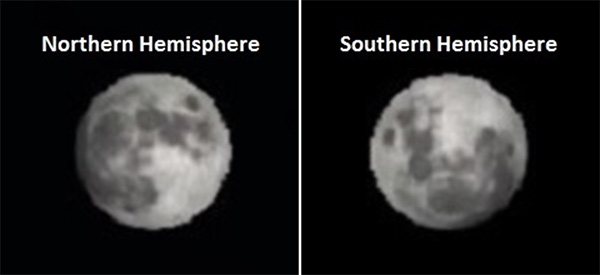
Every person in the Northern Hemisphere, when they look up at the full moon, sees a face like a smiling snowman—the man in the moon. Throughout history, he has inspired legends.
In many European cultures, he was a man banished to the moon for stealing from his neighbors—or for working on Sunday. (Good thing that’s not a banishable offense today!)
Coastal Germans, recognizing the moon’s tidal connection, believed he was a giant who poured water on Earth to create high tide.
In Norse legend, the man kidnapped two children to have them fetch that water, a story that would become Jack and Jill.
In the Southern Hemisphere, however, the man’s face is upside down, which makes it look like a rabbit—with legends all its own.
The eyes of the man and the body of the rabbit are actually basalt flats caused by ancient lava flows. But why do all people on Earth see this same view?
The answer is something called tidal locking—most moons are tidally locked to their planets.
Soon after the moon formed, the powerful pull of Earth’s gravity created a bulge near the moon’s equator.
Gravity kept pulling the bulge toward Earth, slowing the moon’s rotation till it was perfectly in synch with the moon’s orbit around Earth, meaning that only one side of it faces Earth, and always will.
So what exactly is on the other side of the moon? You’ll have to wait till another EarthDate to find out.
Background
Synopsis: On Earth we always see the same side of the moon; it orbits in perfect sync with Earth’s rotation. Dark shapes on the face of the moon have inspired folklore through the ages. In the Northern Hemisphere, we tell stories about the “man in the moon,” while our equatorial and Southern Hemisphere friends picture the “rabbit in the moon.”
- Many myths and legends about the moon relate to our view of the moon. The orientation of the same dark and light spots on the moon shifts from the Northern Hemisphere to the equator to the Southern Hemisphere, resulting in a variety of stories.
- Many people in the Northern Hemisphere see the face of a man in the moon, but many ancient legends refer to a figure carrying a bundle, sometimes accompanied by a dog or a tool of some sort.
- Most European stories invoke lunar banishment of a man who worked on Sundays or stole from his neighbors.
- Some coastal Germans believed that a giant on the moon caused high tides when he poured water on Earth and ebb tides when he stood up to rest.
- Inuits in Alaska believe the man in the moon is the keeper of the souls of men and animals, and that shamans can ascend to the moon to meet with him.
- In Norse legend, the moon kidnaps two children and makes them fetch water, resulting in the nursery rhyme about Jack and Jill.
- In Malaysia, the man in the moon is braiding bark into a fishing line to catch everything on Earth, but a rat gnaws the line and a cat chases the rat, keeping the eternal balance so Earth stays safe.
- In China, the figure is seen as a rabbit grinding the elixir of life with a mortar and pestle for the moon goddess Chang’e, but in Japan and Korea the rabbit is grinding ingredients for rice cakes.
- It’s not as romantic as folklore, but the dark shapes we see on the near side of the moon are actually geologic features.
- Ancient astronomers thought the vast dark spots on the moon were lunar seas, so they called them maria (Latin for seas).
- These huge flat areas—made of basalt, like we see in volcanoes on Earth—were formed by massive lava flows ranging in age from 1 to 4.2 billion years.
- We always see the same side of the moon, no matter what phase it is in.
- If the moon did not rotate—or if it rotated faster than it orbited Earth—we would see both sides as it orbited Earth.
- Instead, it rotates exactly once each time it orbits Earth—about every 27 days—and thus always shows us the same face.
- Although the moon has a near side and a far side, they are both illuminated by the sun during a lunar month, so there is actually no “Dark Side of the Moon.”
- The perfectly synchronized orbit of moon with Earth, called tidal locking, is caused by gravity.
- The moon’s gravity pulls on Earth, causing the tides of our oceans and a slight bulge at our equator.
- Soon after Earth and the moon formed, Earth’s gravity created a noticeable bulge at the moon’s equator, pulling it toward Earth and slowing the moon’s rotation until it exactly matched its period of revolution around Earth; this tidal locking between the two bodies was established about 4 billion years ago.
- Most moons are tidally locked to their planets, although they may also be influenced by the gravity of sister moons.

